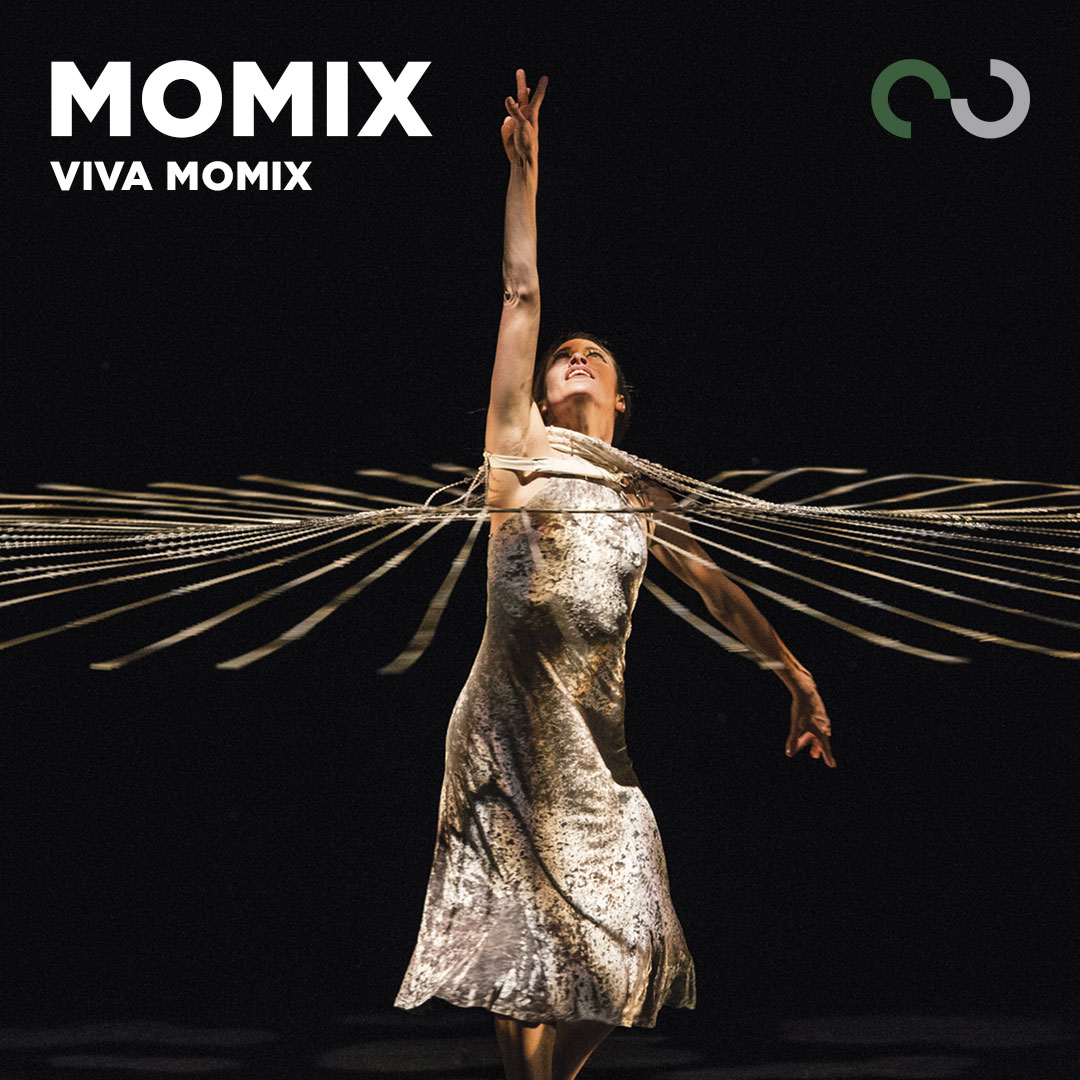

2022-23 SEASON

Month 00, 2022
0:00 PM
_Venue_
Founders
AMALIA HERNÁNDEZ NAVARRO
NORMA LÓPEZ HERNÁNDEZ
Artistic Director
VIVIANA BASANTA HERNÁNDEZ
General Director
SALVADOR LÓPEZ LÓPEZ
Artistic Director
VIVIANA BASANTA HERNÁNDEZ
Artistic Coordinator
Flavio Carlos Antunez Tiburciov
PR & Manager
Laura Becerril Ortiz
Production Manager
Rafael Mendoza Baltazar
Lighting Director
Roberto Carlos Arellano Ramos
Wardrobe
Jose Barrios Gomez
Sound Chief
Julio Cardenas Garcia
Wardrobe
Pedro Cedillo Jiménez
Stagehand
Aldo Misael Lopez Cedillo
Ariana Cavett
Norma Lorena Fernández Romero
Miriam Andrea Flores Osnaya
Alejandra Itzel García Alejandre
Esmeralda Jazmín Hernández Fierros
Andrea Jaime Villanueva
Sofía de Jesús Larrañaga Castillo
Arcelia Danae López Lara
Mariant Monserrat Martínez Vázquez
Laura Victoria Rea Paulino
Jessica Alejandra Resendiz Rodríguez
Adriana Sánchez Ramírez
Sofìa Segura
Ana Paola Zamacona Licona
Marco Antonio Aguirre Macías
Ernesto Alejandro Arellano Ruiz
Ricardo Alejandro Barranco Omaña
Abraham Bravo Ruiz
José Isaac García Marín
Edson Jair González Gonzaga
Adrián Rogelio Hernández Caballero
Aaron Zalahui Hernández Martínez
Tonatiuh Ricardo Hernández Martínez
Gustavo Lemus Lemus
Daniel Adolfo Rodrìguez
Juan Francisco Rodríguez Torreblanca
José David Rosas Andrade
Oscar Yael Tlatelpa Morales
Jorge Torres Chávez
Miguel Aguilar Salas
Javier Camacho Contreras
Oscar Uriel Canul Tec
Raúl Gavia Ríos
Miguel González Nerey
Wlfred Raymundo May Pech
Hector Medina Ramos
Humberto Medina Ramos
José Medina Ramos
Julio Cesar Mora Nieto
Esteban Salinas Cruz
Gilberto Salinas Cruz
Jesús Salinas Cruz
Adib Wuilliams Toledano Rescalvo
Catarino Torres Contreras
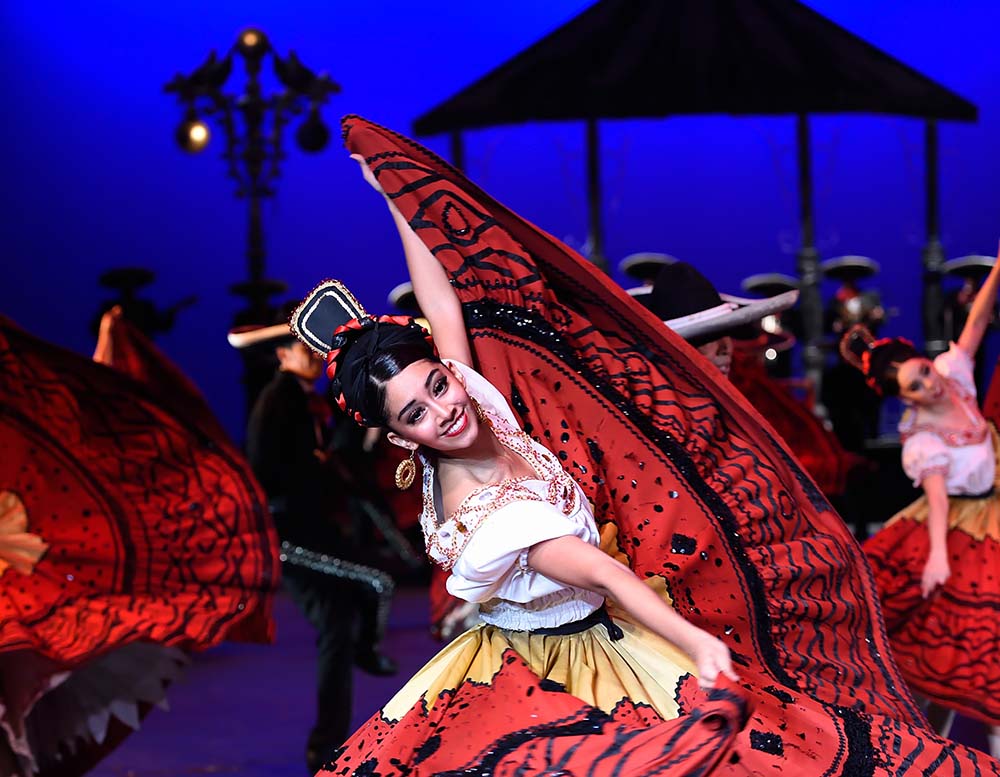
Aztecas (Hijos del sol)
Para esta reconstrucción de danzas rituales aztecas, Amalia Hernández tomó elementos de las crónicas de los conquistadores, los relatos, la escultura y la cerámica, así como de los códices. Este ballet se compone de la danza fúnebre del rey Ahuizótl, viene enseguida la Danza de los Sacerdotes, en honor a Moctezuma II, continúa la Danza de las Doncellas, después la Danza de la Guerra y finaliza con la Danza de la Celebración.
Amalia Hernández took diverse elements from the conquerors' chronicles, sculptures, ceramics, and codices to reconstruct these Aztec ritual dances. This ballet is divided into four dances, the "Dance of the Priests", in honor of Moctezuma II, the "Dance of the Maidens", the "Dance of War", and the "Dance of Celebration".
Sones Antiguos de Michoacán
Esta pieza es un brillante mosaico de bailes y canciones de Michoacán, y una de las coreografías más importantes de Amalia Hernández, pues cambió el rumbo de su carrera, así como el de la danza mexicana. Sones Antiguos de Michoacán combina las técnicas de la danza moderna y clásica para adaptarlas a la danza folclórica; es una evocación del movimiento capturado en el contexto etnográfico. La coreografía es considerada por su creadora como la primera obra inspirada en el folclor, desarrollada de una forma teatral y continúa vigente no solo en el repertorio del Ballet Folklórico de México, sino también como inspiración para otras compañías y agrupaciones de danza folclórica mexicana.
This piece is a brilliant mosaic of dances and songs from Michoacán, and one of the most important choreographies of Amalia Hernández, since it changed the course of her career, as well as Mexican dance. Sones Antiguos de Michoacán combines the techniques of modern and classical dance. The choreography is considered by its creator as the first work inspired developed theatrically and remains not only in the repertoire of the Ballet Folklórico de México but also as an inspiration for other Mexican folk dance companies.
Tarima de Tixtla
Basado en las danzas originarias del estado de Guerrero, Tarima de Tixtla es una de las coreografías más coloridas y alegres en el repertorio del Ballet Folklórico de México. Aquí retumba el eco del zapateado en latarima, enfatizando así, con el ritmo vertiginoso de la alegría, el calor de las almas guerrerenses y la picardía que se sugiere en los movimientos de las bailarinas; ese ajetreo de las faldas y el diálogo que se establece a través de la punta y el talón de los intérpretes.
Based on the original dances of Guerrero, Tarima de Tixtla is one of the most colorful and cheerful choreographies in the Ballet Folklórico de México’s repertoire The echo of the tapping shoes shakes the wooden stand, representing with joy the warmth of the people from Guerrero. The swirl of the skirts and the tapping of the dancers’ feet show an incessant dialogue through dance.
La Revolución
Este ballet está dedicado a las soldaderas o Adelitas, mujeres que tuvieron un papel determinante en la Revolución Mexicana, pues trasladaron su vida y pocas pertenencias a los escenarios bélicos. En rápido contraste se ve a los aristócratas en una alegre celebración, cuando un grupo de rebeldes irrumpe en la fiesta, levantándose en armas para marchar hacia su irremediable destino: la Revolución.
This ballet is dedicated to the "soldaderas", also called Adelitas, women who had a decisive role in the Mexican Revolution, as they took their lives and few belongings to the war scenes. In quick contrast, the aristocrats are seen in a joyous celebration, when a group of rebels breaks into the party, prepared to fight and march towards their destiny: the Revolution.
La Charreada
Una de las tradiciones más arraigadas de México es la Charrería, que surge de las actividades ecuestres y ganaderas de las distintas comunidades del país. Declarada Patrimonio Inmaterial de la Humanidad por la UNESCO, la charrería es un arte y disciplina en la que hombres y mujeres demuestran su valor en las suertes deportivas que provienen del trabajo que se realizaba en las antiguas haciendas de México. Para mantener su popularidad, surgieron asociaciones que mantienen esta tradición vigente a través de las charreadas, que se ejecutan en los lienzos y permiten a los espectadores admirar las destrezas de los charros y jinetes.
One of the most deeply rooted traditions in Mexico is the Charreria, which arises from the equestrian and livestock activities of the different communities of the country. Declared Intangible Heritage of Humanity by UNESCO, Charrería is an art and discipline in which both men and women compete, wearing colorful Mexican costumes trimmed in silver studs. To maintain its popularity, associations were created and also the “Charreadas”, which can be considered as a Mexican rodeo, as well as a highly recognized sport with strict rules and lots of competitions that shows the skills of the “charros” and horsemen.
Fiesta en Tlacotalpan
La danza y la música jarocha tienen una fuerte influencia de la cultura española, es por eso que los bailes están compuestos por movimientos zapateados, característicos del flamenco. Esta fusión se puede apreciar en todo su esplendor durante la celebración de la Virgen de la Candelaria, donde las calles se llenan de mojigangas, bailadores de fandango, jaraneros y bellas mujeres que visten el típico traje veracruzano.
Spanish culture has a strong influence on Jarocha dance and music, which is why there is percussive footwork in every choreography, a distinctive move of flamenco. This fusion can be appreciated during the celebration of the Virgen de la Candelaria, where the streets are filled with mojigangas, fandango dancers, jaraneros, and beautiful women who wear the typical Veracruz costume.
La vida es un juego
Basado en los originales juegos y juguetes mexicanos. Es una sátira que narra un juego controlado por un diablo muy carismático, que maneja a los personajes como si fueran marionetas manipulando las cuerdas para determinar su destino. Realidad y fantasía intervienen cuando el diablo usa a Cupido y a la Muertecita para desarrollar el enredo entre el novio, la novia y el amante. Todo al son de música de feria y fiesta.
This dance is based on Mexican toys and games. The game is controlled by a very charismatic devil that handles all characters as if they were marionettes and with their cords, he manipulates the way to determine their destiny. Reality and fantasy interact when the devil uses both, “Cupid” and “Death” to perform a tangled love story between a bride, her groom and her lover.
Danza del Venado
La Danza del Venado es la representación emblemática del estado de Sonora y es considerada Patrimonio Cultural Inmaterial de la Humanidad por la UNESCO. La Danza del Venado forma parte del rito que se realiza en vísperas de las expediciones de caza y reproduce con asombrosa fidelidad los movimientos de la presa.
The Deer Dance is an emblematic representation of the state of Sonora and is considered an Intangible Cultural Heritage by UNESCO. The Deer Dance is a ritual performed before the hunting expeditions and reproduces the movements of the prey with amazing fidelity.
Fiesta en Jalisco
El estado de Jalisco es la tierra de los Charros, las Chinas y el Mariachi, símbolos de la identidad mexicana y herencia del mestizaje. El brillante folclore jalisciense envuelve en su música, en sus bailes vigorosos y refinados, en sus trajes multicolores y deslumbrantes, lo más noble y puro de la cultura mexicana.
The state of Jalisco is the land of the Charros, the Chinas, and the Mariachi, powerful symbols of Mexican identity. Pure Mexican culture is shown in the brilliant folklore of Jalisco, its music, its vigorous and refined dances, and in its dazzling and multicolored costumes.

Amalia Hernández fue una bailarina y coreógrafa, fundadora en 1952 del Ballet Folklórico de México. Desde muy joven inició un largo trayecto por la cultura mexicana que la llevaría a rescatar las danzas tradicionales de los diversos rincones de México. Ella logró proyectar ante el mundo la belleza de las diferentes regiones de nuestro país a través del movimiento, desde las culturas precolombinas, las influencias españolas en la época del virreinato hasta la fuerza popular de los tiempos revolucionarios.
Con sus primeras presentaciones en 1952 obtuvo el reconocimiento del público como representante cultural de México. Su gran éxito logró establecer al Ballet en el Palacio de Bellas Artes como su sede permanente a partir del 11 de octubre de 1959.
Con más de 30 millones de espectadores e innumerables reconocimientos, el legado artístico de Amalia Hernández permanece vigente gracias a las más de 120 coreografías originales y con gran rigor técnico, elaborados trajes típicos y artistas de primer nivel, consolidándose como la mejor compañía del mundo en su género.
Amalia Hernández was a dancer and choreographer, founder of the Ballet Folklórico de México in 1952. From a very young age, she began a long journey through Mexican culture that would lead her to rescue the traditional dances around Mexico. She managed to project to the world the beauty of our country through movement, from pre-Columbian cultures and Spanish influences to the revolutionary times.
With her first performances in 1952, she obtained public recognition as a cultural representative of Mexico. Her great success established the Ballet in the Palace of Fine Arts as its permanent venue since October 11, 1959.
With more than 30 million spectators and countless recognitions, Amalia Hernández's artistic legacy remains valid thanks to the more than 120 original choreographies with great technical difficulty, elaborate typical costumes, and first-rate artists, consolidating the Ballet as the best dance company in the world in its genre.
Ballet Folkórico de México is produced by CAMI Music LLC
![]() Isaac hurtado
Isaac hurtado
Rodolfo
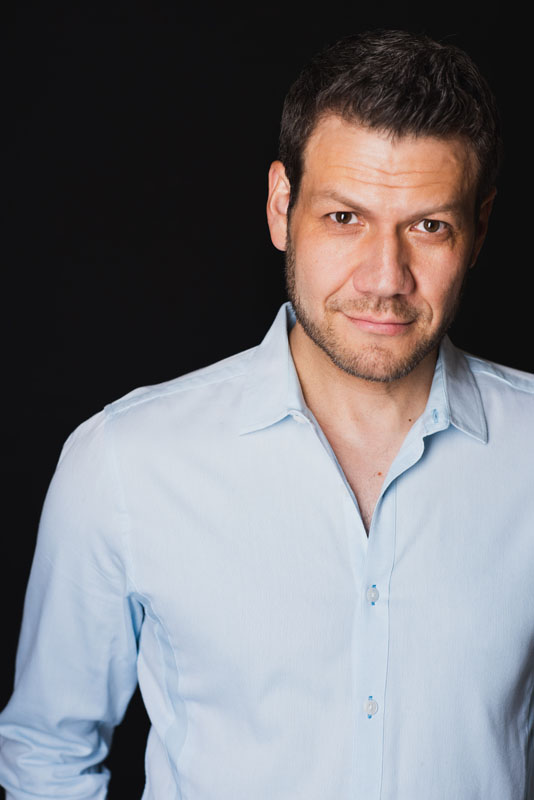 Isaac Hurtado has drawn critical acclaim for performances of over 30 leading tenor
roles across the United States. Since making his leading role debut in 2004 with Festival
Opera (CA) in the title role of Roméo et Juliette, his portrayals of Pinkerton in Madama Butterfly, Rodolfo in La Bohème, Don José in Carmen, Alfredo in La Traviata, Edgardo in Lucia di Lammermoor, Il Duca di Mantova in Rigoletto among others, have been noted for “money notes worth every penny” and “wonderful acting.” He has appeared with companies including Utah Opera, Opera North, Piedmont Opera
(NC), Pine Mountain Music Festival (MI),Opera San Jose (CA), Phoenix Opera (AZ), The
Cleveland Opera (OH), Utah Festival Opera, Central City Opera (CO), the Bay Area’s
Midsummer Mozart Festival (CA), Utah Lyric Opera, and Sun Valley Opera (ID). Most
recently Mr. Hurtado appeared as Don José in Utah Opera’s La Tragedie de Carmen, and was seen in Pesaro and Iesi, Italy performing recitals honoring the 150th anniversary
of Gioachino Rossini’s passing. He will reprise the role of Rodolfo in La Bohème this January at the Noorda Center for the Performing Arts.
Isaac Hurtado has drawn critical acclaim for performances of over 30 leading tenor
roles across the United States. Since making his leading role debut in 2004 with Festival
Opera (CA) in the title role of Roméo et Juliette, his portrayals of Pinkerton in Madama Butterfly, Rodolfo in La Bohème, Don José in Carmen, Alfredo in La Traviata, Edgardo in Lucia di Lammermoor, Il Duca di Mantova in Rigoletto among others, have been noted for “money notes worth every penny” and “wonderful acting.” He has appeared with companies including Utah Opera, Opera North, Piedmont Opera
(NC), Pine Mountain Music Festival (MI),Opera San Jose (CA), Phoenix Opera (AZ), The
Cleveland Opera (OH), Utah Festival Opera, Central City Opera (CO), the Bay Area’s
Midsummer Mozart Festival (CA), Utah Lyric Opera, and Sun Valley Opera (ID). Most
recently Mr. Hurtado appeared as Don José in Utah Opera’s La Tragedie de Carmen, and was seen in Pesaro and Iesi, Italy performing recitals honoring the 150th anniversary
of Gioachino Rossini’s passing. He will reprise the role of Rodolfo in La Bohème this January at the Noorda Center for the Performing Arts.
In concert, Mr. Hurtado has performed Beethoven’s Ninth Symphony with the West Michigan Symphony Orchestra, Liszt’s A Faust Symphony with the Traverse Symphony Orchestra, Bach’s Magnificat and G Major Mass with Sacramento Choral Society and Orchestra, Messiah with the for Southwest Symphony Orchestra, and gala concerts with Utah Symphony and Opera, Festival Opera at Walnut Creek, Temple Square Orchestra and Chorale of Salt Lake City, Santa Rosa Symphony and Martinez Opera.
Mr. Hurtado holds the Assistant Professor of Voice/Director of Opera position at Utah Valley University. He also serves on the voice faculty of the Mediterranean Opera Studio, and is the Executive director of the UVAA Summer Opera Festival.
![]() Melissa Heath
Melissa Heath
Musetta
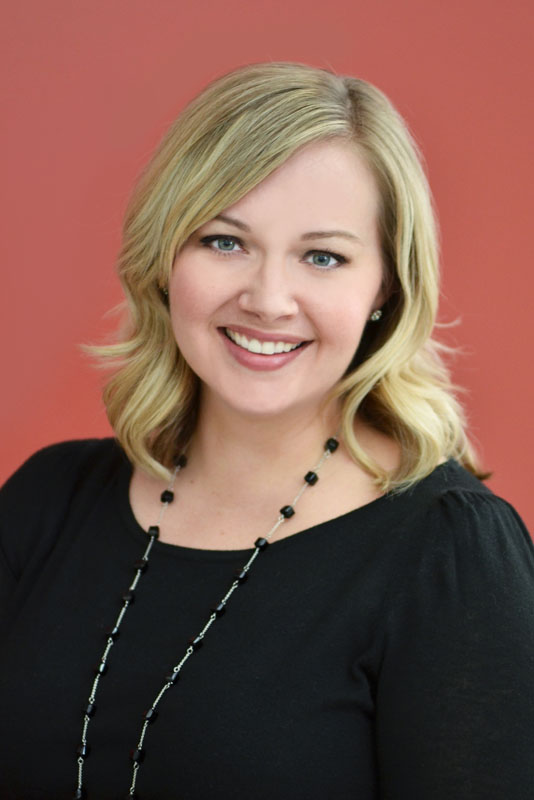 Soprano Melissa Heath enjoys a varied career of opera, concert and recital work. Hailed
as a “soaring, sparkling soprano” with “vivacious stage presence,” recent opera roles
include Countess in Mozart’s Le Nozze di Figaro and Micaëla in Bizet’s Carmen. Recent concert work includes Vaughan Williams’ Dona Nobis Pacem and both Mozart’s Requiem and Mass in c minor with the Temple Square Chorale and Orchestra at Temple Square, Handel’s Messiah with the Mormon Tabernacle Choir, and both Mozart’s Exsultate, jubilate and Barber’s Knoxville, Summer of 1915 with Sinfonia Salt Lake. With Utah Symphony, Ms. Heath has performed both Nielsen’s
Symphony no. 3 and Handel’s Messiah. In November 2017 she was the soprano soloist with Ballet West in choreographer Nicolo
Fonte’s world premiere of Carl Orff’s Carmina Burana, a role she will reprise with the company in April, 2021. In 2018 Ms. Heath had the
pleasure of singing songs of Messiaen and Schubert on NOVA Chamber Music Series’ season
finale concert, and performed recitals in Seattle and New York. In 2019 she sang the
role of The Water in Utah Opera's Production of The Little Prince, Mahler’s Symphony no. 2 with Salt Lake Symphony, and headlined a performance with Utah Symphony in their
Deer Valley Concert Series. Ms. Heath was a district winner in the Metropolitan Opera’s
National Council Auditions, and was a two-time regional finalist in the National Association
of Teachers of Singing’s biennial art song competition. Ms. Heath is an Assistant
Professor of music and the Vocal Area Coordinator in the Department of Music at Utah
Valley University. She holds a Bachelor’s Degree in voice from Brigham Young University,
and her Master of Music and Doctorate of Musical Arts degrees in voice from the University
of Utah.
Soprano Melissa Heath enjoys a varied career of opera, concert and recital work. Hailed
as a “soaring, sparkling soprano” with “vivacious stage presence,” recent opera roles
include Countess in Mozart’s Le Nozze di Figaro and Micaëla in Bizet’s Carmen. Recent concert work includes Vaughan Williams’ Dona Nobis Pacem and both Mozart’s Requiem and Mass in c minor with the Temple Square Chorale and Orchestra at Temple Square, Handel’s Messiah with the Mormon Tabernacle Choir, and both Mozart’s Exsultate, jubilate and Barber’s Knoxville, Summer of 1915 with Sinfonia Salt Lake. With Utah Symphony, Ms. Heath has performed both Nielsen’s
Symphony no. 3 and Handel’s Messiah. In November 2017 she was the soprano soloist with Ballet West in choreographer Nicolo
Fonte’s world premiere of Carl Orff’s Carmina Burana, a role she will reprise with the company in April, 2021. In 2018 Ms. Heath had the
pleasure of singing songs of Messiaen and Schubert on NOVA Chamber Music Series’ season
finale concert, and performed recitals in Seattle and New York. In 2019 she sang the
role of The Water in Utah Opera's Production of The Little Prince, Mahler’s Symphony no. 2 with Salt Lake Symphony, and headlined a performance with Utah Symphony in their
Deer Valley Concert Series. Ms. Heath was a district winner in the Metropolitan Opera’s
National Council Auditions, and was a two-time regional finalist in the National Association
of Teachers of Singing’s biennial art song competition. Ms. Heath is an Assistant
Professor of music and the Vocal Area Coordinator in the Department of Music at Utah
Valley University. She holds a Bachelor’s Degree in voice from Brigham Young University,
and her Master of Music and Doctorate of Musical Arts degrees in voice from the University
of Utah.
![]() Christopher Holmes
Christopher Holmes
Marcello
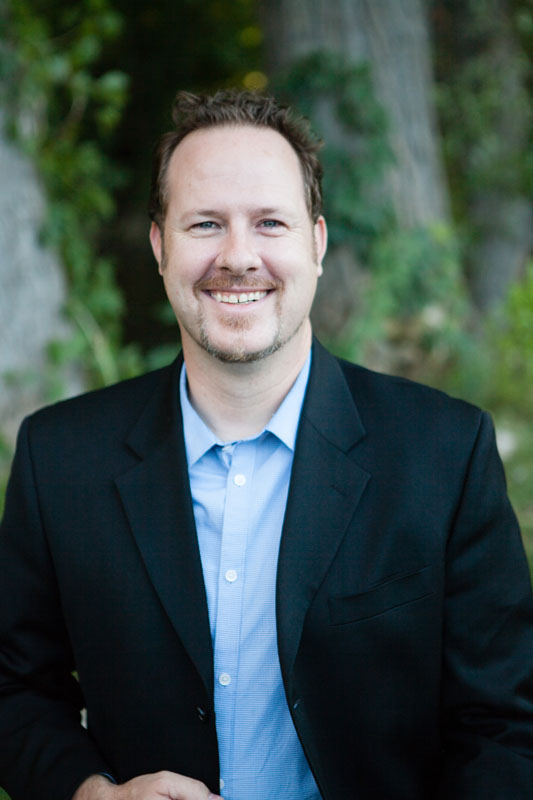 With over 35 operatic roles to his credit, baritone Christopher Holmes has been featured
by companies such as Austin Lyric Opera, Central City Opera, Eugene Opera, Opera Idaho,
Phoenix Opera, Juneau Lyric Opera, and San Antonio Opera.
With over 35 operatic roles to his credit, baritone Christopher Holmes has been featured
by companies such as Austin Lyric Opera, Central City Opera, Eugene Opera, Opera Idaho,
Phoenix Opera, Juneau Lyric Opera, and San Antonio Opera.
A "powerful, melodious baritone" with "soul and passion" is a small sample of enthusiastic reviews being received by Holmes. As a full-lyric baritone, Holmes is beginning to make his mark in the Verdi repertoire. As Iago with Winter Opera St. Louis critics commented, Holmes sings Iago “with clarity and power, and with a skilled actor's ability to convey mood and character" and with “control and subtlety.” As Rigoletto at St. Petersburg Opera a critic indicates that Holmes “had me crying at points -- an incredibly beautiful lyric baritone with a very clear understanding of who this humiliated and terribly wronged man is.” His Germont was praised as “with crystal clear enunciation, truly polished, controlled, professional and superb.” But his versatility continues to make him adept at the bass-baritone roles of Mozart and Rossini such as Don Alfonso in Così fan tutte and Bartolo in Il barbiere di Siviglia.
In 2018/19 he was seen as Barone Douphol in Utah Opera’s La traviata, Conte Almaviva in Utah Festival Opera’s Figaro, Belcore in Opera Company of Middlebury’s production and subsequent tour of L'elisir d’amore, Bartolo in Il barbiere di Siviglia at Western Plains Opera, Escamillo in Carmen with the Pine Mountain Music Festival, and the Pirate King in The Pirates of Penzance at Rimrock Opera/NOVA. Previously he was seen with Cleveland Opera Theater as Figaro in Le nozze di Figaro and made a return to Gulfshore Opera in their production of Speed Dating (M. Ching) and in their tour of "Grand Opera Nights" singing the roles of Figaro (Il barbiere di Siviglia), Marcello (LaBohème), Germont (La traviata), and the title role of Rigoletto.
Mr. Holmes remains active as a concert artist having sung such works as Bach’s St. Matthew Passion and St. John Passion, Beethoven’s 9th Symphony, Brahms' A German Requiem, Gershwin’s Porgy and Bess, Handel’s Messiah, Orff’s Carmina Burana, the Faure Requiem, Mozart's Mass in C Minor and Requiem, Schubert’s Mass in G Major, Vaughan Williams’ Dona nobis pacem, and Verdi's Messa di Requiem.
Matt August
Director
Matt August is a theatre and film director whose productions have broken box-office records on Broadway (Grinch), in London and the UK, played Off-Broadway, major Regional theatres, festivals, National Tours, the Grand Ol’ Opry, and three holiday seasons at Madison Square Garden. They’ve been featured on television, NPR and performed at the White House. He has directed World Premieres, American Premieres and Regional Premieres that have been recognized with nominations and awards from LA’s Ovation, Washington DC’s Helen Hayes, Arizona’s Mac, San Francisco’s Bay Area Critics, Broadway World, Utah’s Audience Choice and Australia’s Helpmann Awards. His work has appeared on Year End Top-Ten lists for the LA Times, San Francisco Chronicle, Huffington Post, Arizona Republic, Oakland Tribune, Tucson Sun, San Jose Mercury News and NPR/KQED. He has been awarded fellowships and residencies from the Old Globe Theatre, Drama League, Oregon Shakespeare Festival, The Acting Company, Robert Wilson’s Watermill Center, the Juilliard School, and San Francisco’s Zen Center. In addition to theatre, he was awarded the Panavision New Filmmakers Grant and directed the award winning short family film How to Get to Candybar. Locally, his productions have been seen at the Capitol Theatre, Pioneer Theatre and at UVU. Regional Premiers include King Charles III and In the Heights; World Premieres of Discord - The Gospel According to Jefferson, Dickens and Tolstoy; The Fourth messenger; Two Dollar Bill, Sixteen WoundedS, Time Flies, Meet John Doe, Liberty Smith and many more, and the UK premier of How the Grinch.... Shakespeare productions include Much Ado About Nothing, Two Gentlemen of Verona, Tempest, Romeo and Juliet, Merry Wives of Windsor. He was the Associate Director to multi-Tony winning director Jack O’Brien on four Broadway productions, including being the Resident Director on Tom Stoppard’s The Invention of Love when both lead actors received Tony Awards, and on the Tony winning Henry IV (Best Director and Best Revival.) He is a scholar on the work of Howard Barker and Robert Wilson, and currently teaches directing at UVU. More info at MattAugust.com
Nicolas Giusti
Music Director/Conductor
Nicolas Giusti is an acclaimed Italian composer and opera conductor. He has had great success with many operatic productions, such as Die Zauberflote by Mozart, Colyseum Opera House of Oporto (Portugal), Gianni Schicchi (Orbetello Festival with protagonist Giuseppe Taddei); Tosca (with Silvano Carroli, transmitted on RAI radio3); and La Bohème by Puccini at the State Opera House of Izmir (Turkey), the first production of the century in that country. Recently, he has directed and performed in highly competitive opera tournaments.
Emily Beatse
Production Stage Manager
Emily Beatse is excited to be working at the Noorda Center as the Stage Manager for their production of La Bohème. She is a recent graduate from the University of Utah with a BFA in Stage Management. Her professional credits include: The Comedy of Terrors (2nd ASM, Utah Shakespeare Festival), Pirates of Penzance (PA, Utah Shakespeare Festival), Mary Stuart, the Lifespan of a Fact, and The Lion in Winter (2nd ASM, Pioneer Theatre Company). Her previous educational credits include: Tartuffe (SM, Studio 115), Songs for a New World (Livestream Director, Babcock Theatre), Henry V (APM, Zoom), Amahl and the Night Visitors Opera (ASM, The Grand Theatre), A Christmas Carol Opera (ASM, The Grand Theatre), Men on Boats (1st ASM, Studio 115), and Our Country’s Good (ASM, Babcock Theatre).
Peter D. Leonard
Lighting Design
Peter D. Leonard has designed over 300 productions for theaters and dance companies
nationwide. Multiple tours lighting the Dance Theatre of Harlem include:
Lincoln Center, Joyce Theater, Jacob’s Pillow, Kennedy Center, Sadler's Wells (London).
Perry Award nomination: Children of Eden MOC Musicals. Lighting designs for original
musicals: Singin’ Wid A Sword in Ma Han (Audience Favorite award NYC Fringe 2009),
The Deciders and Saddamn: The Musical for Smoke That Thunders, pre-Broadway workshop
of In My Life for Joe Brooks, Nucleo Eclettico at LaMama, Etc; Dorian Gray: The Musical
at NY Musical Theater Festival, Clark Gesner’s Animal
Fair NY premiere.

The Director is a member of the Stage Directors and Choreographers Society, a national theatrical labor union.
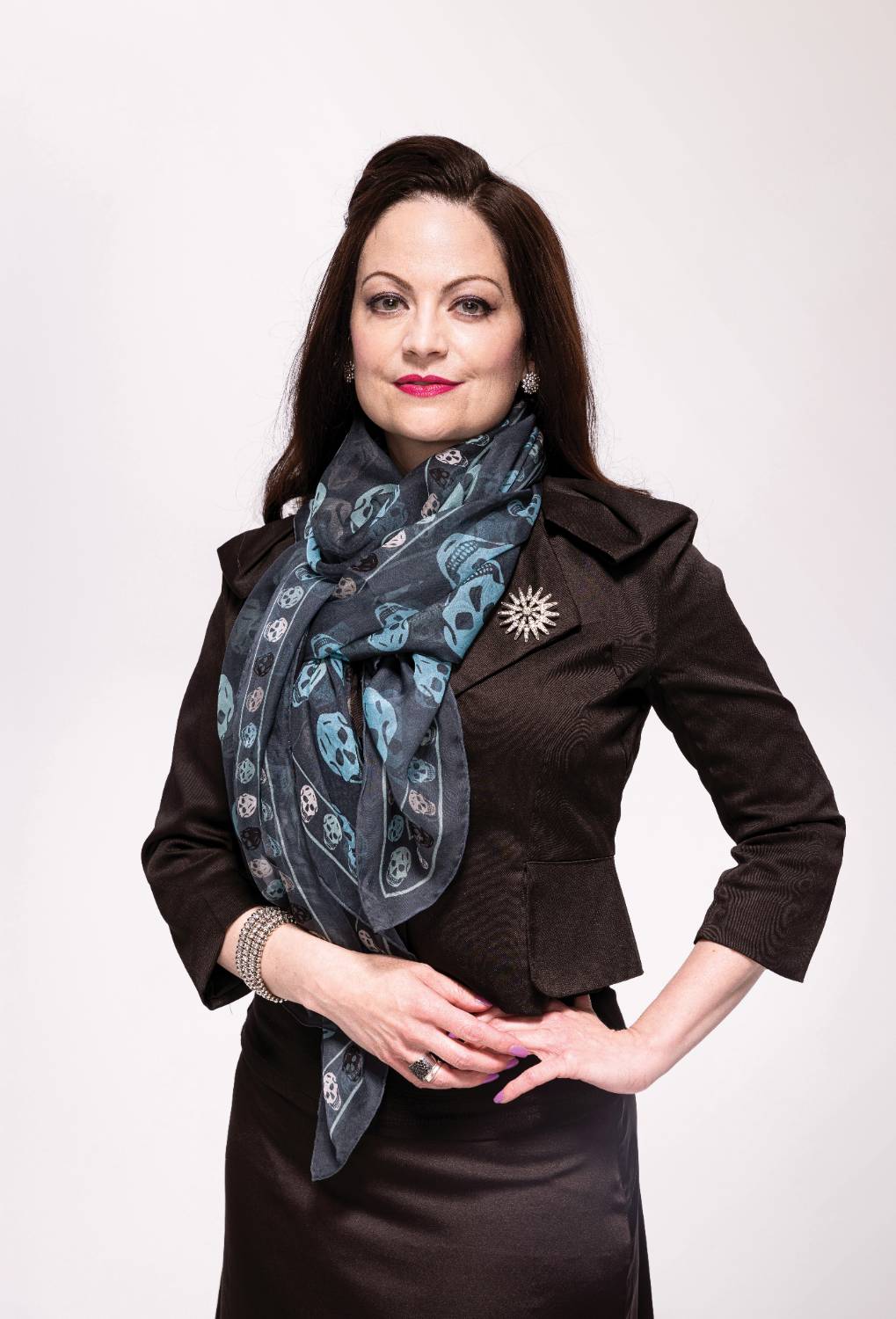
Our mission is to produce and present artistic excellence, which would not be possible without the generous support of our sponsors. We thank them and express our deep gratitude to all patrons, supporters, and friends of The Noorda.
The arts possess the unparalleled power to inspire, educate, liberate, and transform. They elevate moments, mark milestones, soften edges, and generate profound meaning. Experience the beauty and wonder of the arts with us this season at The Noorda and begin at once to live!
Courtney R. Davis, J.D., M.A.
Dean, School of the Arts

Utah Valley University acknowledges that we gather on land sacred to all Indigenous people who came before us in this vast crossroads region. The University is committed to working in partnership—as enacted through education and community activities—with Utah’s Native Nations comprising: the San Juan Southern Paiute, Paiute Indian Tribe of Utah, Uintah & Ouray Reservation of the Northern Ute, Skull Valley Goshute, Confederated Tribes of the Goshute Reservation, Northwestern Band of Shoshone Nation, Hopi Tribe, Navajo Nation, Ute Mountain Ute-White Mesa Community, and urban Indian communities. We recognize these Native Nations and their continued connections with traditional homelands, mountains, rivers, and lakes as well as their sovereign relationships with state and federal governments. We honor their collective memory and continued physical and spiritual presence. We revere their resilience and example in preserving their connections to the Creator and to all their relations, now and in the future.
With this statement comes responsibility and accountability. We resolve to follow
up with actionable items to make the School of the Arts at UVU and The Noorda Center
for the Performing Arts an inclusive, equitable, and just space for all. There is
much work to be done, and we are committed to putting these words into practice.
Artwork by Shane Walking Eagle (Sisseton Dakota).
The Circle is an elite group of arts supporters at The Noorda Center for the Performing Arts. Our goal is simple: to create a sphere of influence that unites those who wish to have a significant impact upon the performers, patrons, and students who are transformed in our center for true artistic collaboration. Your contribution and support will make this impact by enabling The Noorda to bring the greatest talent from across the world through its doors. While here, these performers and artists will collaborate with students, the community, and our youth. Many will set aside time to visit with Circle Members at exclusive VIP events.
Join The Circle today. Call 801-863-4962 or email Tess Fontanetti-Rice [email protected] for more information.
Mr. & Mrs. Alan and Karen Ashton
Mr. Bruce Bastian
Mr. & Mrs. Darren and Lisa Bastian
Mr. & Mrs. Jeff and Cristi Bastian
Mr. & Mrs. Rick and Heather Bastian
Mr. & Mrs. Robbie and Amy Bastian
The Church Of Jesus Christ Of Latter-day Saints
dōTERRA
Mr. & Mrs. Kem and Carolyn Gardner
Barbara Barrington Jones Family Foundation
The Ray and Tye Noorda Family Foundation
Richard E. and Nancy Peery Marriott
Nu Skin
OC Tanner
Mr. & Mrs. Scott and Karen Smith
Utah County Government
Mr. Kim Wilson and Mrs. Gail Miller Wilson
Zions Bank
Mr. and Mrs. Paul and Jeanette Clyde
Clyde Company
Mayor & Mrs. Guy and Paula Fugal
Mr. & Mrs. Brent and Cheri Andrus